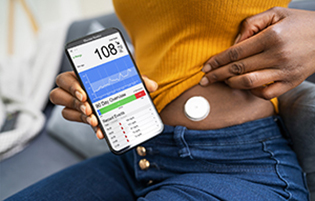What Is Diabetes mellitus (commonly known as diabetes)?
Diabetes is a condition in which the body either does not produce enough insulin or is not able to use insulin effectively by the cells. Insulin is a natural hormone produced by your body’s pancreas gland to control the level of glucose (a type of sugar) in your blood. As a result, if you have diabetes, the glucose in the blood (often called blood sugar) becomes very high.
Although there is no cure for diabetes, it can be controlled with changes in lifestyle (diet and exercise) and treatment. It is important for people with diabetes to be diagnosed and treated as soon as possible, as high blood sugar levels can damage body organs and tissue, resulting in complications such as nerve damage, kidney damage, heart attacks, strokes, peripheral vascular disease (causing leg pain and ulcers in the feet), cataracts and loss of vision, among others.
If you have been recently diagnosed with diabetes, you may feel overwhelmed by the amount of information to take in. Take your time to understand what a diagnosis of diabetes means to you and your health. Over time, the medications, lifestyle changes and test results you need to monitor will become easier to manage. If you keep talking with your diabetes care team, you can live and thrive with diabetes.
Diabetes affects millions of Americans, and the numbers continue to grow every year.
- More than 34 million people in the U.S. are living with diabetes, which equals about 10.5% of the country’s population.
- About 7.3 million people living with diabetes in the U.S. have not yet been diagnosed and may be unaware of their condition.
- Almost 90 million U.S. adults have prediabetes (abnormal blood glucose that is not high to make the diagnosis of diabetes).
- Every year, 1.5 million more Americans get diagnosed with diabetes.
- Diabetes affects racial and ethnic groups in the U.S. differently, with American Indian/Alaska Native, Hispanic, Black, and Asian adults impacted at higher rates than white adults.
- Nearly 27% of people over the age of 65 have diabetes.
Source: Centers for Disease Control and Prevention. National Diabetes Statistics Report, 2020. Atlanta, GA: Centers for Disease Control and Prevention, U.S. Dept of Health and Human Services; 2020.
What Are the Different Types of Diabetes?
There are multiple types of diabetes but the three main types are: type 1 diabetes, type 2 diabetes and gestational diabetes. Each type of diabetes has different causes and effects in the body and is associated with distinct risk factors. What they have in common is an inability to control blood sugar levels.
Type 1 diabetes (previously also known as juvenile diabetes or insulin-dependent diabetes)
Type 1 diabetes develops when the cells that produce insulin in the pancreas (beta cells) are mistakenly destroyed by a person’s own immune system. The body is unable to produce enough insulin, which means that blood sugar is not controlled and can become very high. Only about 5% of people with diabetes have this type. Type 1 diabetes typically occurs in children and young adults but may occur at any age.
Type 2 diabetes (previously also known as adult onset diabetes or non-insulin dependent diabetes)
Type 2 diabetes occurs when the body cells are unable to effectively use the insulin. The cells becomes resistant to the effects of insulin, which results in uncontrolled blood sugar. Type 2 diabetes typically occurs in people over the age of 30 who are overweight or obese. However, this type of diabetes is becoming more common in younger age groups due to increases in the number of children and young adults who are overweight and obese.
Gestational diabetes
Gestational diabetes is a type of diabetes that develops during pregnancy. It is caused by the hormones of pregnancy or by an insufficient amount of insulin. This type of diabetes is usually temporary and goes away after the end of pregnancy, although this is not always the case. Children whose mothers had gestational diabetes while they were in the womb have a greater chance of developing diabetes later in life.
What Is Prediabetes?
Although diabetes can appear without warning, most people go through a stage of prediabetes or "impaired glucose tolerance" prior to developing diabetes.
If you have prediabetes, the good news is that you can reduce the likelihood of developing diabetes by changing what you eat and how physically active you are.
- Adding physical activity into your daily routine can help prevent or delay type 2 diabetes if you are an adult at high risk of developing diabetes.
- Incorporating a lifestyle that emphasizes healthy eating with low carbohydrates (sugars) can help prevent type 2 diabetes and manage prediabetes. Working with a registered dietitian to develop a personal meal plan that helps you lose weight is a great way to manage this task.
What Are the Symptoms of Diabetes?
The symptoms below are common to both type 1 and type 2 diabetes. However, people with type 2 diabetes may not show any symptoms.
- Increased thirst
- Increased urination (due to the high blood sugar, which passes through the kidneys to increase volume of urine)
- Feeling very hungry
- Feeling very tired
- Losing weight without trying (people with diabetes are unable to absorb and use the energy from sugar in the blood)
How Is Diabetes Diagnosed?
Diabetes can be diagnosed by a health care provider based on a person’s symptoms and a blood test. There are three types of blood tests used to diagnose diabetes:
- Fasting blood glucose (sugar): For this test, a person is asked not to eat anything for at least eight hours before blood is drawn. A result of 126 mg/dl or higher results makes the diagnosis of diabetes.
- Oral Glucose tolerance test: With this test, the diabetes care team first measures a person’s fasting glucose (as above). The person is given a drink that contains 75 grams of glucose, and another blood sugar measurement is taken two hours later. A result of 200 mg/dl or higher results in the diagnosis of diabetes.
- Hemoglobin A1c (HbA1c): This is a blood test that shows the average blood glucose over the previous three months. A result of 6.5% or higher results in the diagnosis of diabetes.
Your diabetes care team will likely repeat the blood test to confirm the diagnosis. Find endocrine care in your area.
How Is Diabetes Treated?
Changes in your lifestyle, such as increasing physical activity and making healthy eating choices, are the most important ways to treat diabetes, specially type 2 diabetes. Counting the carbohydrates in your food, for example, should become routine as carbohydrates contribute to high blood sugar. Physical activity is essential because muscles that are regularly exercised consume sugar more efficiently than muscles that are inactive. In addition to these lifestyle changes, there are medications available for both type 1 and type 2 diabetes.
People with diabetes also should keep some candy or sugar drink on hand at all the times in case of a low blood sugar emergency, called hypoglycemia. Talk with your diabetes care team about how to prevent and be prepared for a low blood sugar emergency.
Type 1 diabetes
People with type 1 diabetes must inject insulin since most or all of their insulin-producing cells are usually destroyed by the time they are diagnosed. There are different ways to deliver insulin, including with a syringe, pen or an insulin pump (continuous). The best method to use depends on the specific person and is a decision made together with the diabetes care team.
Type 2 diabetes
The first and most important treatments for people with type 2 diabetes are changes in lifestyle such as diet and exercise. If these changes do not adequately control blood sugar, medication will likely be needed. The choice of medicine depends on the needs of the individual and what is causing the diabetes.
Looking Ahead
Researchers are constantly looking into new and more reliable treatments, such as regenerating cells that can produce insulin and transplanting them into a person’s pancreas. Other treatments that researchers are working on include drugs called incretins and Amylin (already available) that work in complex ways to make the body respond better to the insulin that is available. Alternative ways of taking insulin have been developed (for example inhaled insulin) or are in development. There are other types of research including studies looking into immunosuppressants for type 1 diabetes.
Living with Diabetes
If you have diabetes, how do you know that everything is under control? There are a few different ways that you and your diabetes care team can monitor your glucose levels:
- If you are using an insulin pump that is paired with a Continuous Glucose Monitoring (CGM) system, your diabetes care team can receive updates on the data that is collected.
- You can monitor blood sugar levels at home using a glucometer, which is a device that tests the amount of glucose in your blood. The device can be linked to an app on a smartphone so you can monitor the measurements.
- How often you should use this device to check your glucose levels varies from a few times per week to four to six times each day.
- A HbA1c blood test should be done at least every three months by your diabetes care team. This test reflects how well your glucose levels have been controlled over the previous several months.
- Normal HbA1c levels are less than 5.7%; most people with diabetes should aim for less than 6.5% but this number should be individualized by patient characteristics.
Regardless of how you monitor your blood glucose levels, make sure to discuss the different options with your diabetes care team and ask what your goal blood glucose and HbA1c levels should be. Additionally, if using at home devices, ask your team how often you should check your glucose levels.
What Are Complications of Diabetes?
People with diabetes are at higher risk of various other conditions (often called complications) due to the damaging effects of the disease on blood vessels. Managing your diabetes is key for preventing or delaying these complications, which include diabetic eye disease such as retinopathy, diabetic kidney disease (nephropathy), diabetic nerve disease (neuropathy), heart attacks and stroke.
The good news is that keeping the blood glucose levels as close to normal as possible has been shown to reduce the risk of diabetic retinopathy and kidney disease. Maintaining a healthy lifestyle, including managing blood pressure and cholesterol levels, can also lower the risk of stroke and heart attacks.
Below are some ways you and your diabetes care team can keep track of your health and watch for complications:
- Keep your blood glucose levels at ranges as close to normal as possible and monitor them regularly.
- Get your urine tested at least once a year. The results can be used to check if you may have early kidney disease based on the levels of microalbumin in the urine.
- Get the following tests on a regular basis:
- Blood pressure measurement (on every visit to your provider)
- Cholesterol and triglyceride levels (at least once a year)
- Eye and foot exams with a simple nerve function test (called the monofilament test) (at least once a year)




